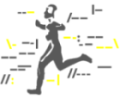





Search | Sitemap | Navigation |  |
|
||||||||||||||||||||||||||
|
||||||||||||||||||||||||||
|
||||||||||||||||||||||||||
|
| Yayoi Kusama |
Giorgio de Chirico (1888-1978)
Fondazione Giorgio e Isa de Chirico
The Italian painter Giorgio de Chirico is more and more appreciated as one of the emblematic figures of 20th century art. He has developed the style of "metaphysical art" and is seen as one of the forerunners of surrealism. Whereas current interpretations of his work by art historians and art critics focus on the literary and philosophical sources of de Chirico's poetics, e.g. the writings from Schopenhauer and Nietzsche, the British neurologist G.N. Fuller and the art historian M.V. Gale suggested, in a paper published as early as 1988 in the British Medical Journal, that migraine with aura may have acted as a basis for several unusual and recurrent features of his "Pittura metafisica".
Reconsidering the notion of de Chirico's migraine aura as source of his artistic inspiration, Ubaldo Nicola and Klaus Podoll have systematically examined his published works as painter and writer, including his "Memoirs", the semi-autobiographical novels "Hebdomeros" and "Mister Dudron" and his collected essays. References to migraine aura symptoms were identified according to phenomenal similarities not only with clinical descriptions of such phenomena as established in neurological semeiology, but also with the paintings and drawings from the Migraine Art collection which currently consists of 562 pieces.
The available documents provided unexpectedly rich evidence for a diagnosis of migraine with aura, as summarized in the monograph "The aura of Giorgio de Chirico - Migraine Art and Metaphysical Painting".
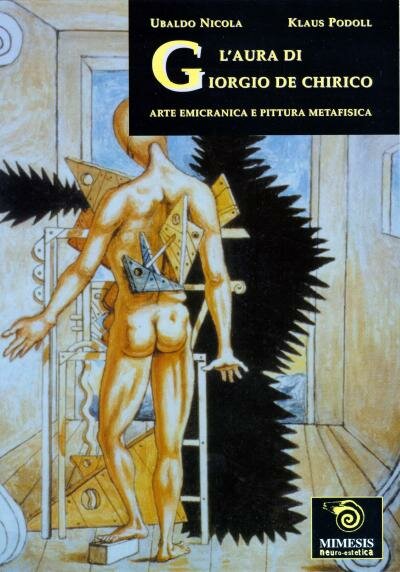
Nicola & Podoll, L'aura di Giorgio de Chirico, 2003. © 2004 Mimesis Edizioni
As an expansion of Fuller' and Gale's previously reported findings, it was possible to document familiarity, childhood onset and a wide range of symptoms of de Chirico's migraine with aura as described in his writings. Blanke and Landis (2003) objected that the available evidence suggests a diagnosis of temporal lobe epilepsy (TLE) rather than migraine, but major criticisms can be raised against their selection and interpretation of data (Podoll and Nicola, 2004) and according to the present author's opinion they failed to demonstrate convincing links between the assumed diagnosis of TLE and de Chirico's metaphysical painting (Blanke and Landis, 2004).
Symptoms of migraine documented in Giorgio de Chirico's writings
|
Analysis of de Chirico's essays on his notion of "revelation" and his autobiographical report on the creation of his first metaphysical painting (The Enigma of an Autumn Afternoon 1909) demonstrate that migraine aura phenomena − especially paramnesias (jamais and déjà vu) and visual phenomena - can be identified at the heart of the painter's creative process during the formative years of development of his unique style of metaphysical art.
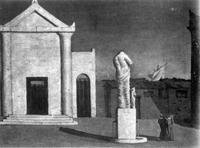
Giorgio de Chirico, The enigma of an autumn afternoon, 1909. © VG Bild-Kunst, Bonn 2005
Giorgio de Chirico's revelation in Florence, 1909"... let me recount how I had the revelation of a picture that I will show this year at the Salon d'Automne, entitled Enigma of an Autumn Afternoon. One clear autumnal afternoon I was sitting on a bench in the middle of the Piazza Santa Croce in Florence. It was of course not the first time I had seen this square. I had just come out of a long and painful intestinal illness [abdominal migraine], and I was in a nearly morbid state of sensitivity [hypersensitivity to light and noise; migraine aura phenomena]. The whole world, down to the marble of the buildings and the fountains, seemed to me to be convalescent. In the middle of the square rises a statue of Dante draped in a long cloak, holding his works clasped against his body, his laurel-crowned head bent thoughtfully earthward. The statue is in white marble, but time has given it a grey cast, very agreeable to the eye [photophobia]. The autumn sun, warm and unloving [photophobia; exposure to sun as trigger factor of migraine attack], lit the statue and the church façade. Then I had the strange impression that I was looking at all these things for the first time [jamais vu], and the composition of my picture came to my mind's eye. Now each time I look at this painting I again see that moment. Nevertheless the moment is an enigma to me, for it is inexplicable. And I like also to call the work which sprang from it an enigma." (Giorgio de Chirico, Parisian manuscripts; cited from Soby, 1955, p. 251; additions in square brackets by Klaus Podoll) |
A question on migraine headaches − Excerpts from a Usenet Newsgroups discussion"I am curious to know where most surrealists stand on the use of drugs (both illegal and legal), and the sensations brought about by the loss of blood to the brain (the headache). Are these manipulations of the mind (brought about by outside forces and internal loss), plausible to categorize under the surrealist experience?" (Brandon J. Freels, Newsgroups: alt.surrealism, Re: Question on Drugs and Headaches, October 20, 1998) "yes." (J. Michael, Newsgroups:alt.surrealism, Re: Question on Drugs and Headaches, October 20, 1998) "Migraine Headaches have been claimed by some sufferers to induce a trance-like state during which they experience enhanced creativity. [...] I say, take your inspiration from wherever you can get it... its quicksilver glimmerings mayn't be stored for long, so you must warehouse as many inspirational inspirations as possible. Just be sure to have a lot of aspirin on hand..." (elag, Newsgroups:alt.surrealism, Re: Question on Drugs and Headaches, October 20, 1998) "The reason why I posted my question is due to my own contradictory views. On one hand I see the use of drugs as unsurreal, because you are experiencing the drug, and not yourself − but in cases of bodily transformations (headache, fever, etc) you are not experiencing yourself either, but the loss or gain of something into the body. But I also am wondering if one can not achieve the surrealist view by subsiding to what we consider today to be 'healthy,' or even a 'healthy mindset' therefore verifying the use of drugs, and any other effect on the body as a positive way to create the surrealist experience. So maybe now people understand my self induced confusion. It seems that the only surrealist experiences I have are based on some physical or mental trauma, and if this is so they why shouldn't the drug induced trauma be considered surrealist also? I simple don't know how to answer my own question." (Brandon J. Freels, Newsgroups:alt.surrealism, Re: Question on Drugs and Headaches, October 21, 1998) |
A comparison of de Chirico's pictorial work with images drawn and painted by other migraine sufferers shows striking similarities which suggest headaches, photophobia, scotoma, visual hallucinations and illusions as well as body image disturbances like macrosomatognosia and out-of-body experiences as sources of his artistic inspiration.

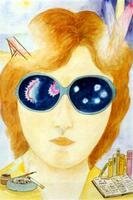
(left) Giorgio de Chirico, Ritratto di Apollinaire, 1914. © VG Bild-Kunst, Bonn 2005 (right) Migraine Art: Photophobia. © 2004 Migraine Action Association and Boehringer Ingelheim
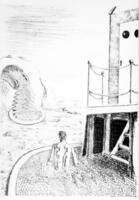
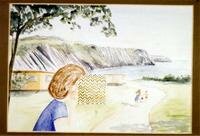
(left) Giorgio de Chirico, Il bagnante solitario, 1934. © VG Bild-Kunst, Bonn 2005 (right) Migraine Art: Visual aura with parallel zigzags. © 2004 Migraine Action Association and Boehringer Ingelheim
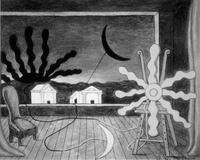
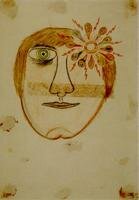
(left) Giorgio de Chirico, Sole sul cavaletto, 1972. © VG Bild-Kunst, Bonn 2005 (right) Migraine Art: Visual aura with radial symmetrical patterns. © 2004 Migraine Action Association and Boehringer Ingelheim
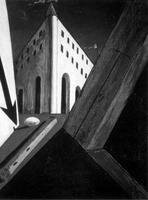
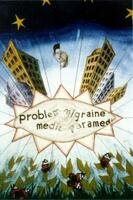
(left) Giorgio de Chirico, Il giorno di festa, 1914. © VG Bild-Kunst, Bonn 2005 (right)Migraine Art: Metamorphopsia. © 2004 Migraine Action Association and Boehringer Ingelheim
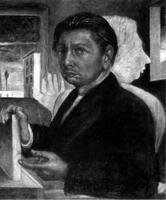
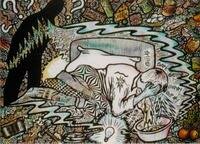
(left) Giorgio de Chirico, Autoritrattio (con ombra), 1920. © VG Bild-Kunst, Bonn 2005 (right) Migraine Art: Out-of-body experience with duplicate phantom body. © 2004 Migraine Action Association and Boehringer Ingelheim
Giorgio de Chirico: The artist and his doubleThe notion of the double has attracted the attention of both scientists and artists, as has recently been shown in a documentary film by Daniel Müller, "The Second Body" (2003). Among other examples from the history of art, the film includes a sequence about Giorgio de Chirico's double as represented in his Self-portrait (with shadow) from 1920. The white shape of a life-sized human body with the characteristic profile of de Chirico's head is depicted back to the artist's physical body which is represented in full colour and detail. The white human-shaped figure is in its entirety located in the invisible sector of space behind the artist's head, which clearly excludes an interpretation in terms of heautoscopy or seeing one's double, but rather indicates an out-out-body experience with the somesthetic sensation of a duplicate or parasomatic body with an extracampine localization behind the physical body. The apparent merging of the artist's physical body and his duplicate body suggests that de Chirico has depicted the process of either separation or return of the parasomatic body from or to the physical body, respectively. Our explanation in terms of an out-of-body experience, which may occur as a migraine aura symptom, complies with previous interpretations of the artist's self-portrait with shadow. Thus, Wieland Schmied (1980) wrote: "Behind the artist in his dark jacket a bright, almost white shadow turns away. It is as if his alter ego detached itself from him, as if a part of his self left him." Fagiolo dell'Arco (1984) gave the following interpretation: "The most surprising peculiarity consists of the white shadow which detaches itself from his body and looks outwards, quasi transforming into an animistic double (in 1919, in an important writing, de Chirico spoke of the 'Ka, a double of ours ...'". In fact, in de Chirico's essay 'Metaphysical art and occult sciences', the painter has referred to "the fact of considering the possibility of existence of immaterial forms, of imagining a double of ours, a Ka of ours... made up of fluids and of incorporeal substances". |
A painting exhibition "Migraine Art: Works and Words Between Headache and Metaphysics?", was organized by the Accademia Romana del Mal di Testa (A.Ro.Ma.T), Alleanza Cefalalgici (Al.Ce.Group - CIRNA Foundation) and the University Center for Adaptive Disorders and Headache (UCADH) as an event accompanying the XI Congress of the International Headache Society (IHC 2003) in Rome, Italy, 13th - 16th September 2003. The show was displayed at the Circolo Brutium at Via IV Novembre 152, curated by the Cà d'Oro Gallery, in collaboration with the Giorgio and Isa de Chirico Foundation − with 18 oil paintings and four calligraphies by Giorgio de Chirico.

Exhibition "ARTeMICRANIA: opere e parole tra mal di testa e metafisica?" (Migraine Art: Works and Words Between Headache and Metaphysics?), Rome, September 10-17, 2003. © 2004 Galleria Cà d'Oro
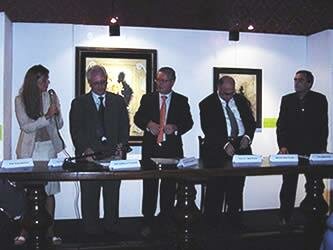
Opening of the Exhibition "Migraine Art: Works and Words Between Headache and Metaphysics?", Rome, September 11, 2003. From left to right: "Gloria Porcella, Prof. Giuseppe Nappi, On. Pino Nisticò, Avv. Paolo Picozza." (www.ca-doro.com/gloria/foto4.htm, May 30, 2004) © 2004 Galleria Cà d'Oro
The present endeavour of a sort of "neuro-psycho-pathography" of de Chirico's life and work contributes fresh evidence to the current discussions on the discipline of neuroesthetics founded by Semir Zeki in the 1990s, demonstrating the impact of a spectrum of neuropsychological phenomena resulting from a neurological disorder, viz. migraine, on one of the greatest artistic revolutions in the 20th century. However, one must not misunderstood the identification of Giorgio de Chirico's migraine as a source of inspiration in the sense of a unidimensional reductionism. In "Mister Dudron", de Chirico wrote: "One must decoct a very precise and special dosage from the various sources from which one draws one's inspiration." To explore these various sources of meaning is the fascinating adventure offered to the viewer by de Chirico's "Pittura metafisica".
References
Blanke O, Landis T. The metaphysical art of Giorgio de Chirico. Migraine or epilepsy? Eur Neurol 2003; 50: 191-194. View or print article as PDF (141 KB)
Blanke O, Landis T. Giorgio de Chirico: Intricate Links between Spiritual Fevers, Metaphysical Art, and the Interictal Temporal Lobe Syndrome. A Reply to Podoll and Nicola. Eur Neurol 2004; 51:187.
Bogousslavsky J. The neurology of art - the example of Giorgio de Chirico. Eur Neurol 2003; 50: 189-190. [PDF]
Emery AEH . Art and neurology. Practical neurology 2004; 4: 366-371.
Fagiolo dell'Arco M. L'opera completa di de Chirico 1908-1924. Rizzoli Editore, Milan 1984.
Fuller GN, Gale MV. Migraine aura as artistic inspiration. Br Med J 1988; 297: 1670-1672.
Nicola U. Giorgio de Chirico ed emicrania. Lic News - Notiziario della Lega Italiana Cefalalgici 2001; 1 (no. 2): 3-4.
Nicola U, Podoll K. L'enigma di Giorgio de Chirico. La nascita della pittura metafisica dallo spirito dell'emicrania. Confinia Cephalalgica 2002; 11: 9-24.
Nicola U, Podoll K. L'aura di Giorgio de Chirico. Arte emicranica e pittura metafisica. Mimesis, Milan 2003.
Nicola U, Podoll K. Le avventure di Giorgio de Chirico nel paese dell'emicrania; in Porcella G (ed): Arte emicrania? Opere e parole tra mal di testa & metafisica. Il Cigno Edizioni, Roma 2003, pp 5-9.
Nicola U, Podoll K. The migraine of Giorgio de Chirico. Cephalalgia 2003; 23: 625.
Podoll K, Nicola U. The illness of Giorgio de Chirico - migraine or epilepsy? Eur Neurol 2004; 51:186.
Podoll K, Nicola U. Pathographie und Neuropsychologie: Die Migräne Giorgio de Chiricos und die Geburt der metaphysischen Malerei. Nervenarzt 2004; 75 (Suppl 2): S258-259.
Podoll K, Robinson D, Nicola U. The migraine of Giorgio de Chirico. Part I: History of illness. Neurol Psychiat Brain Res 2001; 9: 139-156.
Podoll K, Robinson D, Nicola U. Giorgio de Chirico/Alberto Savinio - Die andere Moderne. Die Geburt der metaphysischen Malerei aus dem Geist der Migräne. Dtsch Ärztebl 2002; 99: A449-A450.
Podoll K, Robinson D, Nicola U: Retrospektive zu de Chirico und Savinio in München - Bilderwelten, geprägt durch die Migräne. MMW Fortschr Med 2002; 144: 57.
Podoll K, Robinson D, Nicola U: Die Migräne Giorgio de Chiricos als Inspirationsquelle der metaphysischen Malerei. Schmerz 2002; 16 (Suppl 1): S86.
Sances G. Artemicrania? Opere e parole tra mal di testa e metafisica. Confinia Cephalalgica 2003; 12: 181-182.
Schmied W. "Pictor classicus sum" - Giorgio de Chiricos Rückkehr zur Tradition der Meister. In: Schmied W, Jouffroy A, Fagiolo dell'Arco M, Porzio D (eds) De Chirico. Leben und Werk. Prestel, München 1980, 99-114.
Soby JT. Giorgio de Chirico. Museum of Modern Art, New York, 1955.
Reviews of the book by Nicola and Podoll (2003)
Anonymous. L'arte di de Chirico? Solo mal di testa. La Provincia Pavese, June 15, 2003
Anonymous. L'emicrania di De Chirico? Segno di genialità. La Provincia Pavese, June 17, 2003.
Audisio E. Il mal di testa "metafisico" di Giorgio de Chirico. La Repubblica, June 15, 2003.
Giacovazzo M. L'arte di de Chirico? La cefalea non c'entra. Sfatato il rapporto tra Metafisica e mal di testa. Il Tempo, January 2004 (lost webpage http://www.ilgiornaleideale.it/show.asp?art=3698)
Gramiccia R. Le emicranie di de Chirico. Liberazione, August 6, 2003.
Picascia ML. Recensione. Confinia Cephalalgica 2003; 12:179-180.
Ticini LF. Elogio del dolore. STILE arte n. 70, July/August 2003.
Author: Klaus Podoll
Last modification of this page: Wednesday March 23. 2005
| Yayoi Kusama |
 Top of the page
Top of the page| · | News |
| · | Medical Professionals |
| · | Medical Studies |
| · | Paramnesias |
| · | Friedrich Nietzsche |
| · | Debbie Ayles |
| · | JJ Ignatius Brennan |
| · | Creighton Michael |
Copyright © 2005 Migraine Aura Foundation, All rights reserved. Last modification of this site: August 25, 2006
Thanks to: RAFFELT MEDIENDESIGN and GNU software | webmaster@migraine-aura.org
http://migraine-aura.org/EN/Giorgio_de_Chirico.html
